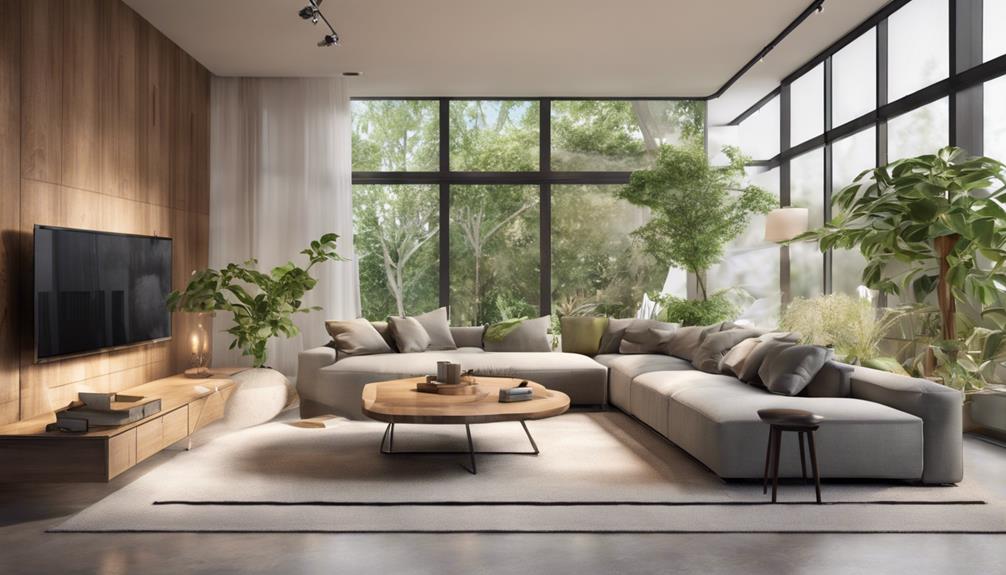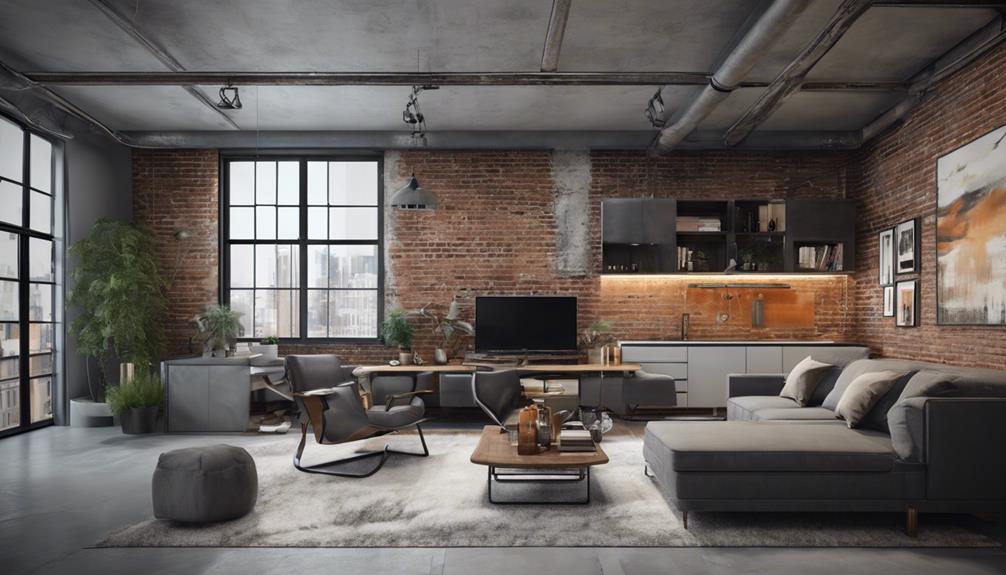Targeting 7 key demographics in the interior design industry is vital. It is crucial to understand millennials, baby boomers, luxury clients, eco-conscious consumers, families with children, urban dwellers, and commercial businesses. Millennials prioritize authenticity and sustainability. Baby boomers lean towards classic, durable designs. Luxury clients are all about sophistication and exclusivity. Eco-conscious consumers value green practices. Families require kid-friendly spaces. Urban dwellers look for modern aesthetics and functionality. Commercial businesses need flexible designs. Each demographic has unique needs and preferences that interior designers must consider for successful projects. Being familiar with these groups can lead to tailored designs that meet specific client requirements.
Key Takeaways
- Prioritize authenticity, sustainability, and personalization for millennial clients.
- Emphasize quality, comfort, and longevity for baby boomer clients.
- Provide sophisticated, bespoke designs for luxury clients.
- Showcase expertise in green design for eco-conscious consumers.
- Design kid-friendly spaces with safety features for families with children.
Millennials
Millennials, comprising a significant segment of the interior design market, prioritize authenticity, sustainability, and personalization in their design choices. This generation values genuine materials, eco-friendly practices, and spaces that reflect their individuality.
Being tech-savvy, millennials often turn to digital platforms for design inspiration and shopping, seeking convenience and a wide array of options at their fingertips. Additionally, they place a high value on experiences over material possessions, influencing their interior design preferences towards spaces that cater to creating memorable moments.
Understanding millennials' preferences presents substantial business opportunities and potential growth in the interior design industry. By aligning with their values of authenticity, sustainability, and personalization, businesses can attract and cater to this influential demographic. Leveraging digital tools to engage with millennials and offering experiences rather than just products can set businesses apart in a competitive market.
Adapting to meet the needs and desires of millennials can lead to increased success and relevance in the ever-evolving field of interior design.
Baby Boomers

Representing a significant demographic in the interior design business, Baby Boomers born between 1946 and 1964 prioritize quality, comfort, and longevity in their design choices. As homeowners, they're willing to invest in home renovations and interior design services that reflect their values. Baby Boomers lean towards classic and shift styles, appreciating classic and timeless aesthetics that focus on functionality. Understanding their design preferences is vital for interior designers looking to cater to this demographic effectively.
When working with Baby Boomers, it's essential to emphasize durability and comfort in the design process. They gravitate towards pieces that exude quality and stand the test of time while providing a cozy and inviting atmosphere in their homes. Incorporating elements that evoke a sense of nostalgia or familiarity can also resonate well with this group. By aligning with Baby Boomers' preferences for classic and shift styles that prioritize comfort and longevity, interior designers can create spaces that truly speak to this demographic.
Luxury Clients

Luxury clients in the interior design industry possess significant wealth, enabling them to demand top-tier services and sophisticated design solutions. Their preferences center around exclusivity, superior quality, and distinctive design features that exude luxury.
To cater to this clientele, interior designers must have a keen eye for upscale trends and establish exclusive partnerships with high-end vendors to deliver bespoke creations.
High-End Design Preferences
In the domain of high-end interior design, affluent clients often gravitate towards bespoke, exclusive designs that reflect their individual style and preferences.
When catering to luxury clients, it's important to take into account their inclination for premium materials, custom furnishings, and high-end finishes. These clients typically value the expertise and reputation of top interior designers, seeking a personalized and attentive design experience.
Attention to detail, impeccable craftsmanship, and exceptional service are key components that high-end clients expect in their interior design projects.
Additionally, high-end design preferences often include incorporating rare or limited-edition pieces, sophisticated technology integration, and luxurious amenities for a truly upscale living or working environment.
Exclusive Sourcing Partnerships
Elevating the caliber of materials and products available to high-end interior design clients, exclusive sourcing partnerships with luxury brands play an essential role in creating unique and distinguished projects. Collaboration with prestigious brands offers access to unique, high-quality, and limited-edition items, setting luxury projects apart in the competitive market.
Access to exclusive collections and custom pieces through sourcing partnerships enhances the bespoke experience for affluent clientele. These partnerships enable designers to cater to discerning tastes, providing rare and exceptional design elements that differentiate them in the luxury market.
Eco-Conscious Consumers

When targeting eco-conscious consumers in the interior design business, it's essential to emphasize expertise in green design practices and showcase sustainable projects in portfolios. Understanding the priorities of this demographic, who value sustainability and environmental responsibility, is vital for interior designers looking to cater to their needs effectively.
Here are some key points to keep in mind when targeting eco-conscious consumers:
- Highlight eco-friendly materials and energy-efficient products in your designs.
- Obtain certifications such as LEED or GreenGuard to demonstrate your dedication to sustainable practices.
- Incorporate innovative sustainable practices like upcycling and energy-efficient lighting solutions.
- Educate clients on the benefits of green design and how it aligns with their environmental values.
Families With Children

Shifting focus to families with children, the interior design approach adapts to accommodate essential and kid-friendly spaces. Designing for this demographic involves considering various factors such as safety features, multi-functional spaces, and playful elements. Families with children require spaces that aren't only aesthetically pleasing but also practical and durable to withstand the demands of daily life. When designing for families with children, it's essential to incorporate features like durable and easy-to-clean materials, ample storage for toys, and safety measures to guarantee a secure environment for kids to play and explore.
Creating multi-functional spaces that can grow and evolve with the children is vital in family-friendly design. Understanding the lifestyle and routines of these families helps in tailoring the design to meet their specific needs and preferences. By incorporating bright colors, interactive elements, and thoughtful design considerations, interior designers can create spaces that cater to the unique requirements of families with children, making the home a safe, functional, and enjoyable environment for all.
Urban Dwellers

Urban dwellers demand interior designs that seamlessly blend modern aesthetics with functional and space-saving solutions. Understanding their lifestyle preferences is essential for interior designers targeting this audience effectively.
Here are key considerations when catering to urban dwellers:
- Smart Home Features: Integrating technology for convenience and efficiency in daily tasks.
- Eco-friendly Materials: Using sustainable resources to align with their environmentally conscious mindset.
- Personalized Interiors: Creating unique spaces that reflect their individuality and style.
- Design Trends: Staying updated on the latest urban design trends to meet their evolving tastes.
Commercial Businesses

Commercial businesses, such as hotels, restaurants, and offices, present a key demographic for interior designers. Office design trends, retail space layouts, and hospitality decor concepts play vital roles in catering to the needs of commercial clients.
Balancing aesthetics, functionality, and brand representation is essential for successful interior design projects in the commercial sector.
Office Design Trends
In modern commercial office design, the focus is on creating flexible and collaborative workspaces to enhance productivity. Incorporating biophilic design elements like plants and natural light is popular, while sustainable and eco-friendly designs aim to reduce environmental impact and promote employee well-being. Ergonomic furniture and adjustable workstations are key trends prioritizing employee health and comfort.
Additionally, technology integration, such as smart lighting systems and interactive workspaces, is on the rise to enhance efficiency and connectivity. This holistic approach to office design not only improves the physical workspace but also positively impacts employee well-being and overall productivity in commercial businesses.
Retail Space Layouts
Shifting the focus from office design trends, retail space layouts play an essential role in maximizing customer engagement and driving sales for commercial businesses. Understanding the importance of interior design in retail spaces is key to optimizing customer flow, enhancing sales, and improving overall customer satisfaction.
Efficient layouts can greatly impact the shopping experience by increasing brand visibility and strategically placing products to influence purchasing decisions. Tailoring these layouts to different demographics is necessary for meeting specific customer needs and preferences effectively. Signage placement also plays a crucial role in guiding customers through the store and highlighting promotions.
Hospitality Decor Concepts
How can hospitality decor concepts in businesses elevate the guest experience and boost customer satisfaction?
Implementing innovative design solutions and collaborating with business owners to tailor decor concepts that align with target customer preferences are key.
Design elements such as lighting, furniture arrangement, color schemes, and textures play a crucial role in shaping the ambiance of hospitality spaces.
Prioritizing functionality, aesthetics, and comfort in commercial businesses creates inviting spaces that enhance the overall guest experience.
Frequently Asked Questions
Who Are the Target Audiences for Interior Design?
As an interior designer, the target audiences encompass residential customers looking to enhance their living spaces and commercial clients like hotels, restaurants, offices, property developers, and manufacturers.
By understanding criteria such as age, location, income, education level, and occupation, one can effectively tailor design solutions to meet their specific needs and preferences.
Customer-oriented approaches are key in successfully reaching these diverse target markets in the interior design industry.
What Are Demographics in Interior Design?
Demographics in interior design encompass quantifiable aspects like age, profession, gender, education, income, and more. By understanding these factors, designers can tailor their services to meet the diverse needs of various consumer groups.
Analyzing demographics reveals trends, preferences, and purchasing power within different segments, enhancing business strategies. This information is vital for defining target markets and creating personalized design solutions to attract specific client groups effectively.
What Are the 7 Elements of Design Used in Interior Design and Explain Them?
The 7 elements of design in interior design encompass space, line, form, light, color, texture, and pattern.
Space deals with room area and furniture arrangement for functionality and aesthetics. Line outlines objects, guiding visual flow.
Color sets mood and impacts emotions. Texture and pattern add depth and interest, creating a cohesive design.
These elements work together to create visually appealing and functional spaces.
What Is the Market Segmentation for Interior Designers?
Market segmentation for interior designers involves dividing the market based on key demographics like:
- Age
- Income
- Profession
- Lifestyle preferences
This segmentation helps us tailor services to specific groups of potential clients with unique needs and preferences. Understanding market segmentation allows us to create targeted marketing strategies that resonate with different demographic groups.
Conclusion
To summarize, understanding the diverse demographics in the interior design business is crucial for success. By targeting Millennials, Baby Boomers, Luxury Clients, Eco-Conscious Consumers, Families with Children, Urban Dwellers, and Commercial Businesses, designers can create tailored solutions that meet the unique needs of each group.
It's important to stay informed about trends and preferences within these demographics to provide exceptional service and build lasting relationships with clients. By catering to these key groups, designers can thrive in the competitive interior design industry.









